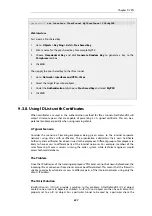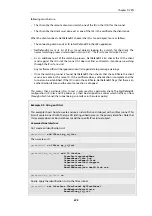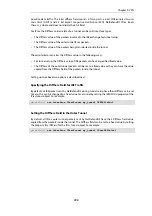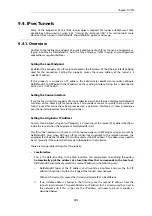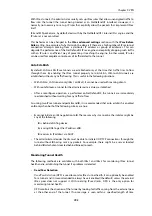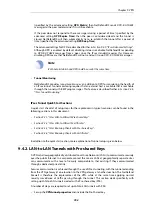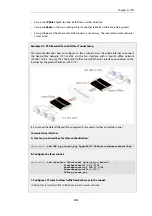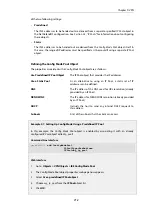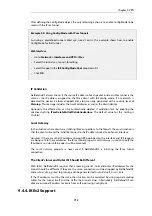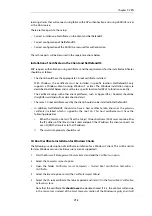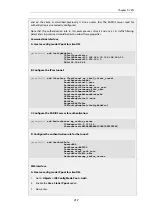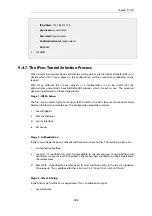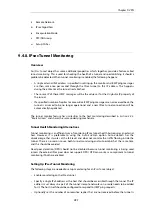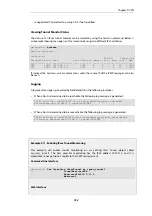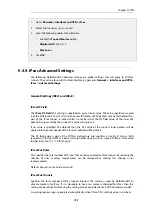
•
Name: RoamingIPsecTunnel
•
Local Network: 203.0.113.0/24 (This is the local network that the roaming users will
connect to)
•
Remote Network: all-nets
•
Remote Endpoint: (None)
3.
For Authentication enter:
•
Choose X.509 Certificates as the authentication method
•
Root Certificate(s): Select the relevant CA server root and add it to the Selected list
•
Gateway Certificate: Choose the relevant firewall certificate
4.
Click OK
C. Finally, configure IP rules to allow the traffic to flow inside the tunnel.
Using Self-signed Certificates
IPsec tunnels in NetDefendOS can be based on self-signed certificates instead of CA signed
certificates. This is configured by having a pair of different self-signed certificates which are both
present on the firewall (or other network device) on either side of the tunnel but have their roles
as root and gateway certificate reversed at either side.
Suppose the self-signed certificate pair are called
cert_A
which is uploaded to or created on
firewall
gateway_A
and
cert_B
which is created on or uploaded to
gateway_B
. On
gateway_A
,
cert_A
is the gateway certificate and
cert_B
is the root certificate for the tunnel. On
gateway_B
,
the situation is reversed:
cert_B
is the gateway certificate and
cert_A
is the root certificate for the
tunnel.
Note that if
cert_A
was created on
gateway_A
, it should not need to be uploaded and its private
key is already available in the key store of
gateway_A
. When
cert_B
is loaded onto
gateway_A
, it is
stored as a root certificate without a private key file. The situation will be the reverse on
gateway_B
.
Certificate Chains
Where there is a certificate chain between the root certificate and the gateway certificate for the
IPsec tunnel, all the intermediate certificates in the chain must be uploaded and then configured
as root certificates for the tunnel.
Using IKE Config Mode
IKE Configuration Mode
(Config Mode) is an extension to IKE that allows NetDefendOS to provide
configuration information to remote IPsec clients. It is used to dynamically configure IPsec clients
with IP addresses and corresponding netmasks, and to exchange other types of information
associated with DHCP. This feature in NetDefendOS only hands out IPv4 addresses.
NetDefendOS contains only a single unnamed
Config Mode Pool
object that hands out IPv4
addresses. It already exists in the Web Interface but must be added when using the CLI. The way
that this object obtains those addresses is determined by setting its
IP Pool Type
property to one
Chapter 9: VPN
711
Summary of Contents for NetDefendOS
Page 30: ...Figure 1 3 Packet Flow Schematic Part III Chapter 1 NetDefendOS Overview 30 ...
Page 32: ...Chapter 1 NetDefendOS Overview 32 ...
Page 144: ...Chapter 2 Management and Maintenance 144 ...
Page 284: ...Chapter 3 Fundamentals 284 ...
Page 392: ...Chapter 4 Routing 392 ...
Page 419: ... Host 2001 DB8 1 MAC 00 90 12 13 14 15 5 Click OK Chapter 5 DHCP Services 419 ...
Page 420: ...Chapter 5 DHCP Services 420 ...
Page 573: ...Chapter 6 Security Mechanisms 573 ...
Page 607: ...Chapter 7 Address Translation 607 ...
Page 666: ...Chapter 8 User Authentication 666 ...
Page 775: ...Chapter 9 VPN 775 ...
Page 819: ...Chapter 10 Traffic Management 819 ...
Page 842: ...Chapter 11 High Availability 842 ...
Page 866: ...Default Enabled Chapter 13 Advanced Settings 866 ...
Page 879: ...Chapter 13 Advanced Settings 879 ...

